Developing Leadership and Management Skills: Marks & Spencer Report
VerifiedAdded on 2021/05/26
|22
|4868
|61
Report
AI Summary
This report provides a comprehensive analysis of leadership and management skills, using Marks and Spencer as a case study. It begins with an overview of Marks and Spencer, followed by a discussion of relevant leadership and management theories. The report then analyzes key performance metrics of Marks and Spencer to assess its organizational leadership and management performance. Different aspects of management, including planning, organizing, staffing, leading, and controlling, are examined, alongside various leadership qualities such as creating unity, enhancing team spirit, and setting clear goals. The report also compares leadership and management, highlighting their differences and similarities. Key performance indicators like average weekly footfall, group revenue, gross margin, group operating profit, and earning per share are discussed in relation to Marks and Spencer's performance. The report concludes with recommendations for Marks and Spencer to improve its leadership and management effectiveness in light of changing business environments.
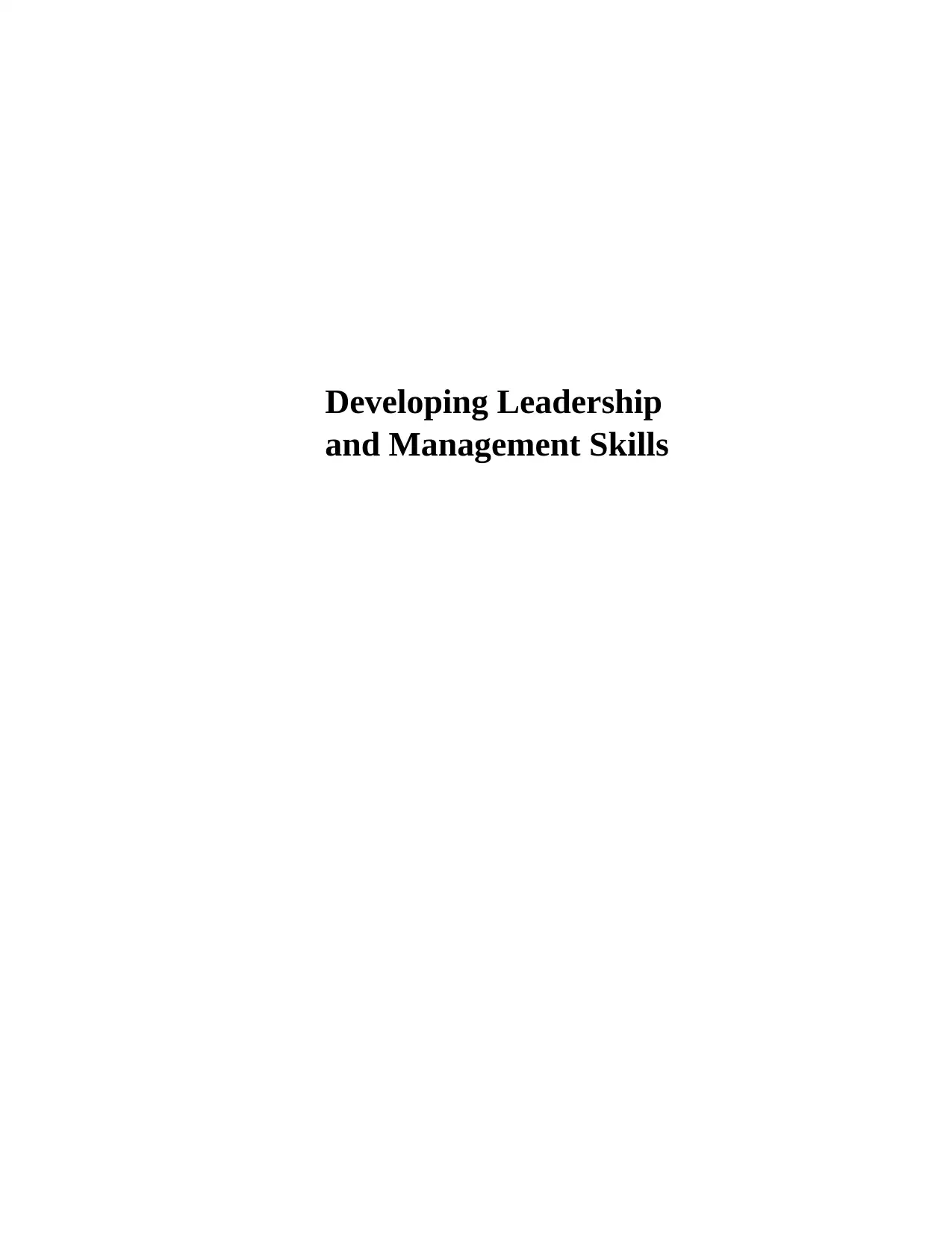
Developing Leadership
and Management Skills
and Management Skills
Paraphrase This Document
Need a fresh take? Get an instant paraphrase of this document with our AI Paraphraser
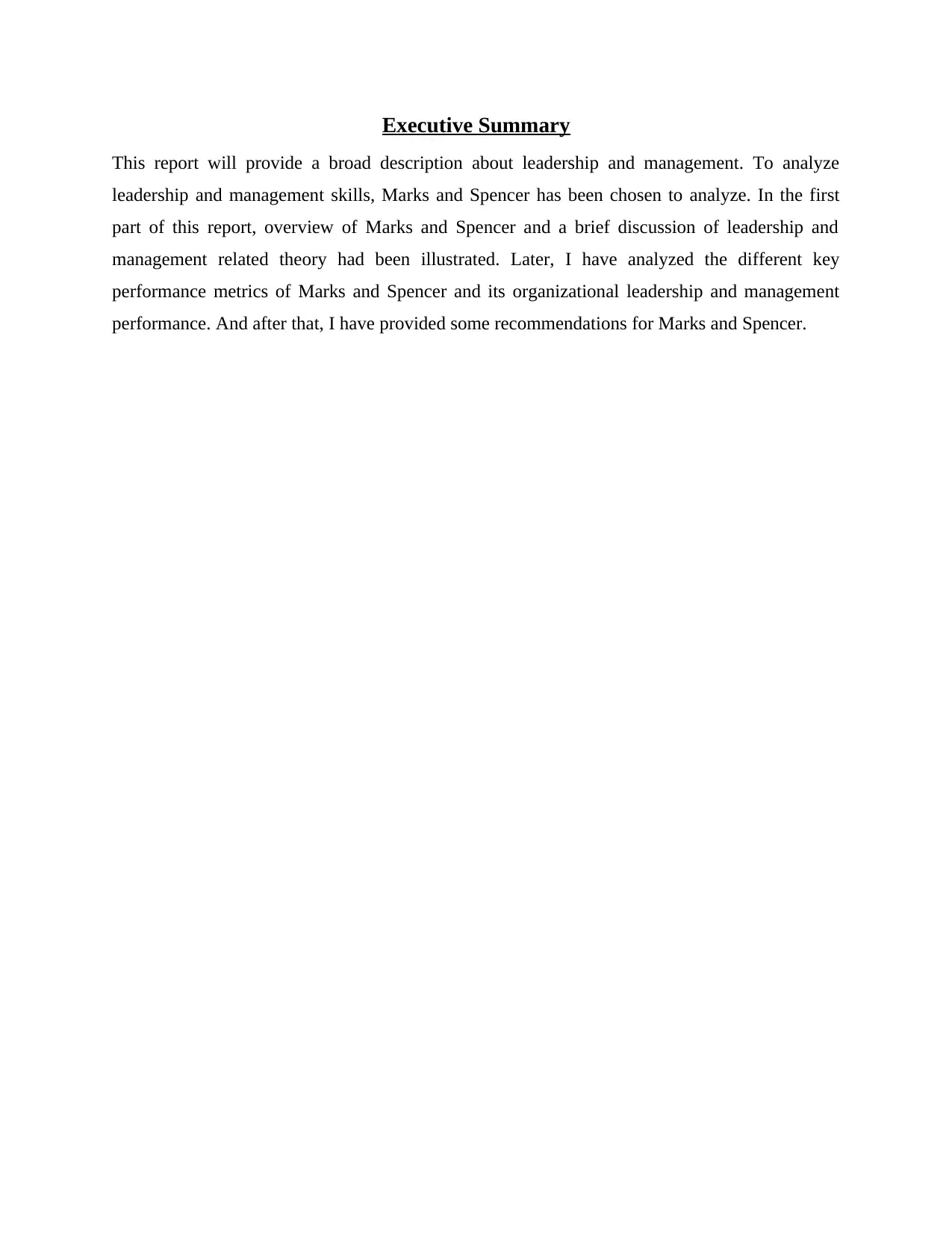
Executive Summary
This report will provide a broad description about leadership and management. To analyze
leadership and management skills, Marks and Spencer has been chosen to analyze. In the first
part of this report, overview of Marks and Spencer and a brief discussion of leadership and
management related theory had been illustrated. Later, I have analyzed the different key
performance metrics of Marks and Spencer and its organizational leadership and management
performance. And after that, I have provided some recommendations for Marks and Spencer.
This report will provide a broad description about leadership and management. To analyze
leadership and management skills, Marks and Spencer has been chosen to analyze. In the first
part of this report, overview of Marks and Spencer and a brief discussion of leadership and
management related theory had been illustrated. Later, I have analyzed the different key
performance metrics of Marks and Spencer and its organizational leadership and management
performance. And after that, I have provided some recommendations for Marks and Spencer.
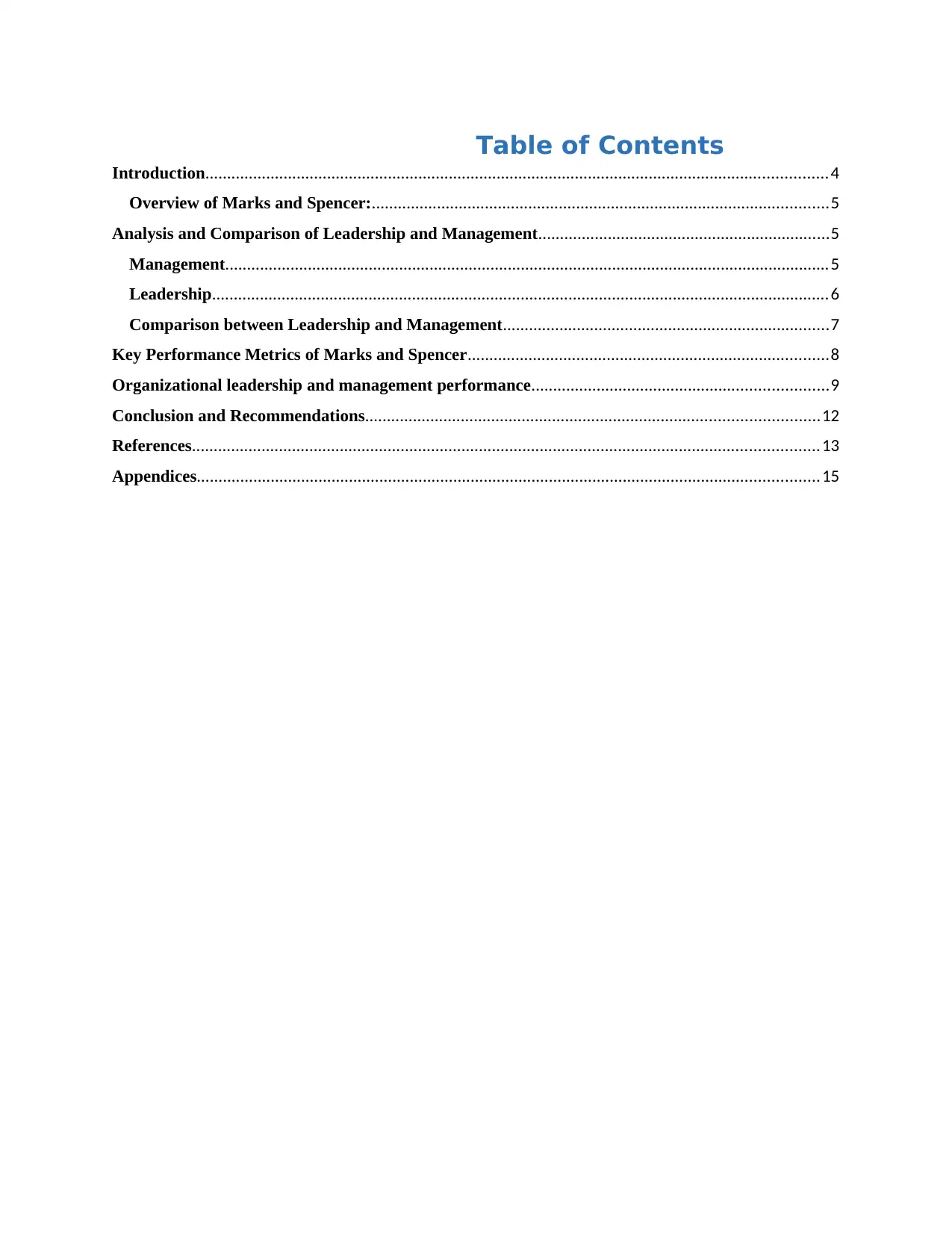
Table of Contents
Introduction...............................................................................................................................................4
Overview of Marks and Spencer:.........................................................................................................5
Analysis and Comparison of Leadership and Management...................................................................5
Management...........................................................................................................................................5
Leadership..............................................................................................................................................6
Comparison between Leadership and Management...........................................................................7
Key Performance Metrics of Marks and Spencer...................................................................................8
Organizational leadership and management performance....................................................................9
Conclusion and Recommendations........................................................................................................12
References................................................................................................................................................13
Appendices...............................................................................................................................................15
Introduction...............................................................................................................................................4
Overview of Marks and Spencer:.........................................................................................................5
Analysis and Comparison of Leadership and Management...................................................................5
Management...........................................................................................................................................5
Leadership..............................................................................................................................................6
Comparison between Leadership and Management...........................................................................7
Key Performance Metrics of Marks and Spencer...................................................................................8
Organizational leadership and management performance....................................................................9
Conclusion and Recommendations........................................................................................................12
References................................................................................................................................................13
Appendices...............................................................................................................................................15
⊘ This is a preview!⊘
Do you want full access?
Subscribe today to unlock all pages.

Trusted by 1+ million students worldwide
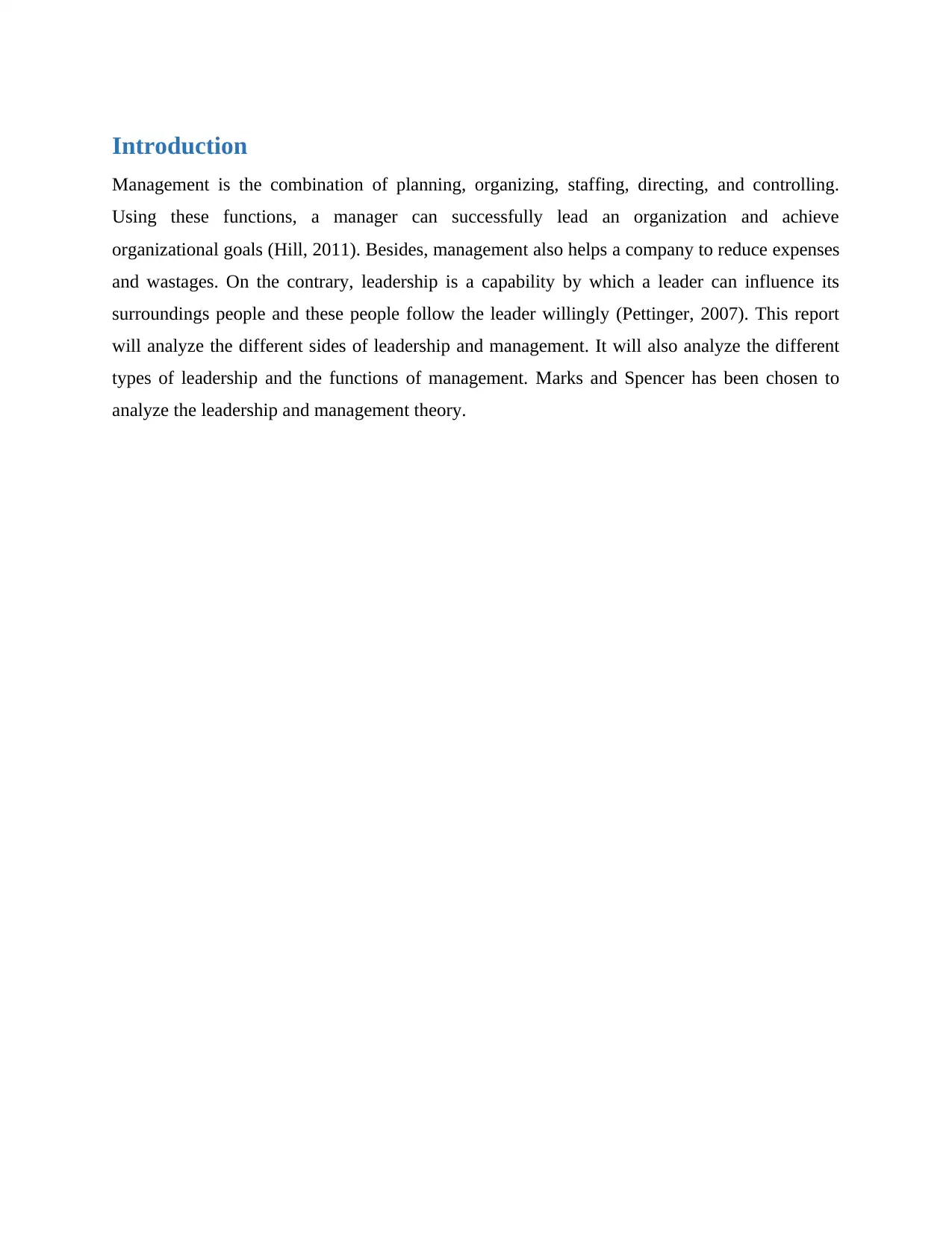
Introduction
Management is the combination of planning, organizing, staffing, directing, and controlling.
Using these functions, a manager can successfully lead an organization and achieve
organizational goals (Hill, 2011). Besides, management also helps a company to reduce expenses
and wastages. On the contrary, leadership is a capability by which a leader can influence its
surroundings people and these people follow the leader willingly (Pettinger, 2007). This report
will analyze the different sides of leadership and management. It will also analyze the different
types of leadership and the functions of management. Marks and Spencer has been chosen to
analyze the leadership and management theory.
Management is the combination of planning, organizing, staffing, directing, and controlling.
Using these functions, a manager can successfully lead an organization and achieve
organizational goals (Hill, 2011). Besides, management also helps a company to reduce expenses
and wastages. On the contrary, leadership is a capability by which a leader can influence its
surroundings people and these people follow the leader willingly (Pettinger, 2007). This report
will analyze the different sides of leadership and management. It will also analyze the different
types of leadership and the functions of management. Marks and Spencer has been chosen to
analyze the leadership and management theory.
Paraphrase This Document
Need a fresh take? Get an instant paraphrase of this document with our AI Paraphraser
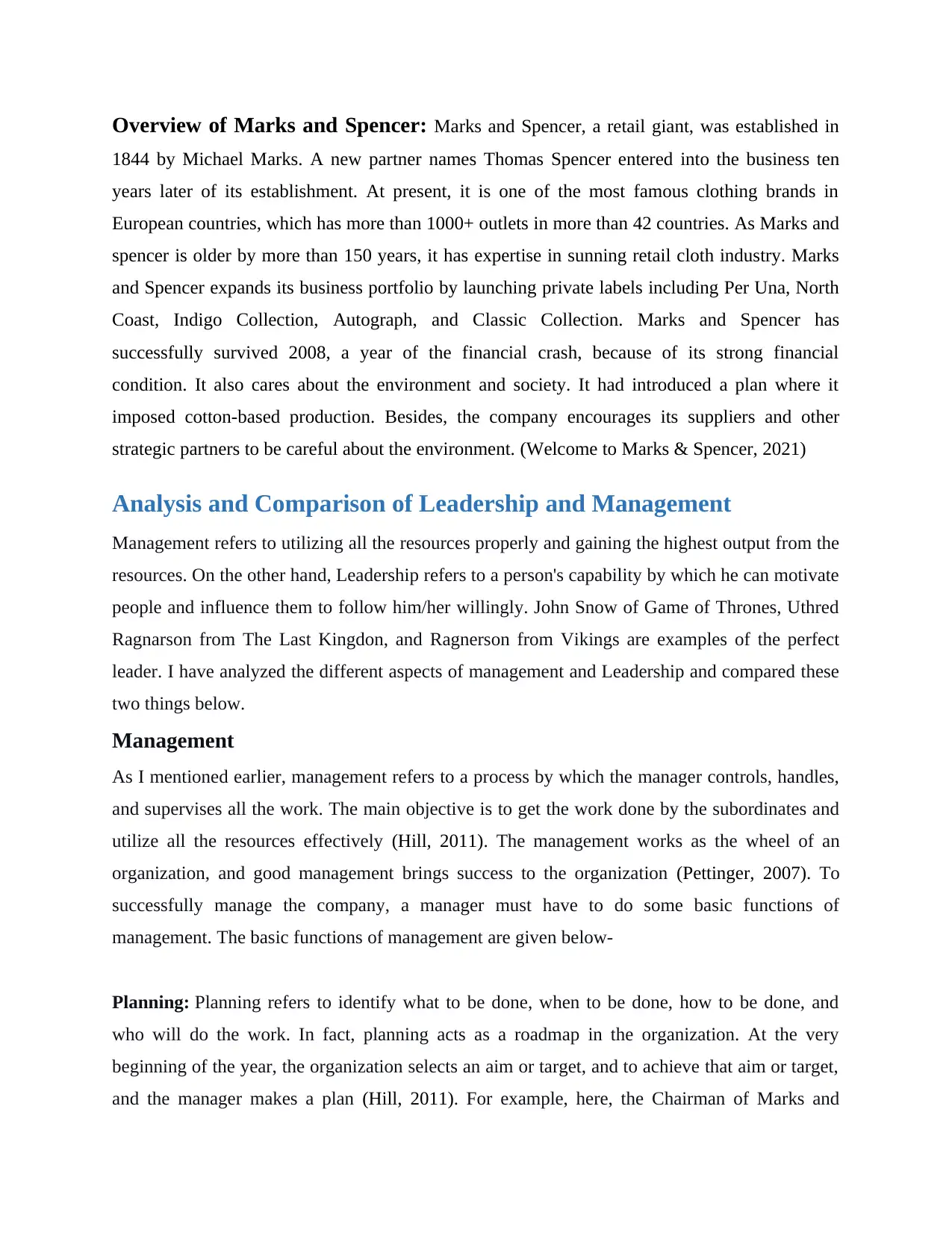
Overview of Marks and Spencer: Marks and Spencer, a retail giant, was established in
1844 by Michael Marks. A new partner names Thomas Spencer entered into the business ten
years later of its establishment. At present, it is one of the most famous clothing brands in
European countries, which has more than 1000+ outlets in more than 42 countries. As Marks and
spencer is older by more than 150 years, it has expertise in sunning retail cloth industry. Marks
and Spencer expands its business portfolio by launching private labels including Per Una, North
Coast, Indigo Collection, Autograph, and Classic Collection. Marks and Spencer has
successfully survived 2008, a year of the financial crash, because of its strong financial
condition. It also cares about the environment and society. It had introduced a plan where it
imposed cotton-based production. Besides, the company encourages its suppliers and other
strategic partners to be careful about the environment. (Welcome to Marks & Spencer, 2021)
Analysis and Comparison of Leadership and Management
Management refers to utilizing all the resources properly and gaining the highest output from the
resources. On the other hand, Leadership refers to a person's capability by which he can motivate
people and influence them to follow him/her willingly. John Snow of Game of Thrones, Uthred
Ragnarson from The Last Kingdon, and Ragnerson from Vikings are examples of the perfect
leader. I have analyzed the different aspects of management and Leadership and compared these
two things below.
Management
As I mentioned earlier, management refers to a process by which the manager controls, handles,
and supervises all the work. The main objective is to get the work done by the subordinates and
utilize all the resources effectively (Hill, 2011). The management works as the wheel of an
organization, and good management brings success to the organization (Pettinger, 2007). To
successfully manage the company, a manager must have to do some basic functions of
management. The basic functions of management are given below-
Planning: Planning refers to identify what to be done, when to be done, how to be done, and
who will do the work. In fact, planning acts as a roadmap in the organization. At the very
beginning of the year, the organization selects an aim or target, and to achieve that aim or target,
and the manager makes a plan (Hill, 2011). For example, here, the Chairman of Marks and
1844 by Michael Marks. A new partner names Thomas Spencer entered into the business ten
years later of its establishment. At present, it is one of the most famous clothing brands in
European countries, which has more than 1000+ outlets in more than 42 countries. As Marks and
spencer is older by more than 150 years, it has expertise in sunning retail cloth industry. Marks
and Spencer expands its business portfolio by launching private labels including Per Una, North
Coast, Indigo Collection, Autograph, and Classic Collection. Marks and Spencer has
successfully survived 2008, a year of the financial crash, because of its strong financial
condition. It also cares about the environment and society. It had introduced a plan where it
imposed cotton-based production. Besides, the company encourages its suppliers and other
strategic partners to be careful about the environment. (Welcome to Marks & Spencer, 2021)
Analysis and Comparison of Leadership and Management
Management refers to utilizing all the resources properly and gaining the highest output from the
resources. On the other hand, Leadership refers to a person's capability by which he can motivate
people and influence them to follow him/her willingly. John Snow of Game of Thrones, Uthred
Ragnarson from The Last Kingdon, and Ragnerson from Vikings are examples of the perfect
leader. I have analyzed the different aspects of management and Leadership and compared these
two things below.
Management
As I mentioned earlier, management refers to a process by which the manager controls, handles,
and supervises all the work. The main objective is to get the work done by the subordinates and
utilize all the resources effectively (Hill, 2011). The management works as the wheel of an
organization, and good management brings success to the organization (Pettinger, 2007). To
successfully manage the company, a manager must have to do some basic functions of
management. The basic functions of management are given below-
Planning: Planning refers to identify what to be done, when to be done, how to be done, and
who will do the work. In fact, planning acts as a roadmap in the organization. At the very
beginning of the year, the organization selects an aim or target, and to achieve that aim or target,
and the manager makes a plan (Hill, 2011). For example, here, the Chairman of Marks and
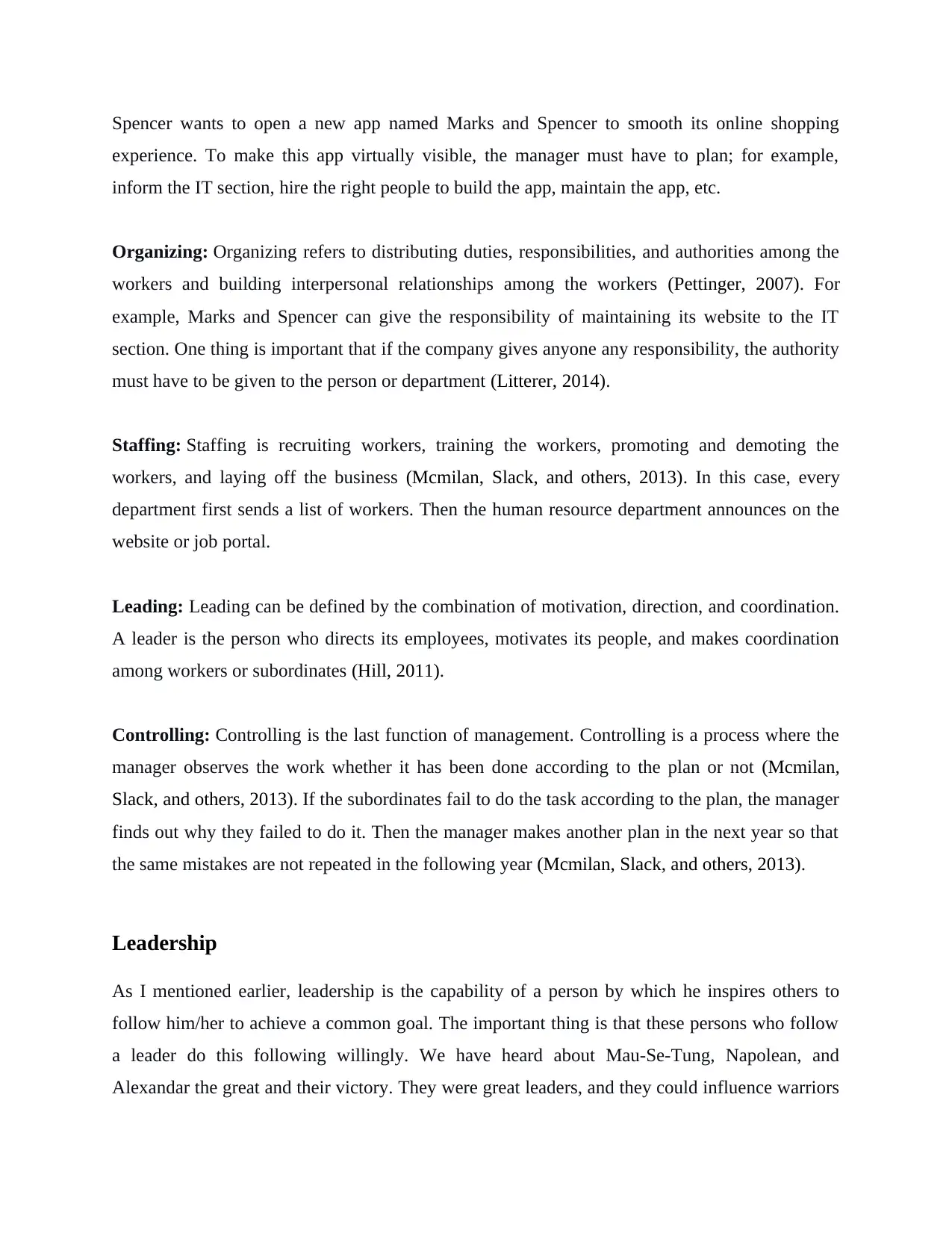
Spencer wants to open a new app named Marks and Spencer to smooth its online shopping
experience. To make this app virtually visible, the manager must have to plan; for example,
inform the IT section, hire the right people to build the app, maintain the app, etc.
Organizing: Organizing refers to distributing duties, responsibilities, and authorities among the
workers and building interpersonal relationships among the workers (Pettinger, 2007). For
example, Marks and Spencer can give the responsibility of maintaining its website to the IT
section. One thing is important that if the company gives anyone any responsibility, the authority
must have to be given to the person or department (Litterer, 2014).
Staffing: Staffing is recruiting workers, training the workers, promoting and demoting the
workers, and laying off the business (Mcmilan, Slack, and others, 2013). In this case, every
department first sends a list of workers. Then the human resource department announces on the
website or job portal.
Leading: Leading can be defined by the combination of motivation, direction, and coordination.
A leader is the person who directs its employees, motivates its people, and makes coordination
among workers or subordinates (Hill, 2011).
Controlling: Controlling is the last function of management. Controlling is a process where the
manager observes the work whether it has been done according to the plan or not (Mcmilan,
Slack, and others, 2013). If the subordinates fail to do the task according to the plan, the manager
finds out why they failed to do it. Then the manager makes another plan in the next year so that
the same mistakes are not repeated in the following year (Mcmilan, Slack, and others, 2013).
Leadership
As I mentioned earlier, leadership is the capability of a person by which he inspires others to
follow him/her to achieve a common goal. The important thing is that these persons who follow
a leader do this following willingly. We have heard about Mau-Se-Tung, Napolean, and
Alexandar the great and their victory. They were great leaders, and they could influence warriors
experience. To make this app virtually visible, the manager must have to plan; for example,
inform the IT section, hire the right people to build the app, maintain the app, etc.
Organizing: Organizing refers to distributing duties, responsibilities, and authorities among the
workers and building interpersonal relationships among the workers (Pettinger, 2007). For
example, Marks and Spencer can give the responsibility of maintaining its website to the IT
section. One thing is important that if the company gives anyone any responsibility, the authority
must have to be given to the person or department (Litterer, 2014).
Staffing: Staffing is recruiting workers, training the workers, promoting and demoting the
workers, and laying off the business (Mcmilan, Slack, and others, 2013). In this case, every
department first sends a list of workers. Then the human resource department announces on the
website or job portal.
Leading: Leading can be defined by the combination of motivation, direction, and coordination.
A leader is the person who directs its employees, motivates its people, and makes coordination
among workers or subordinates (Hill, 2011).
Controlling: Controlling is the last function of management. Controlling is a process where the
manager observes the work whether it has been done according to the plan or not (Mcmilan,
Slack, and others, 2013). If the subordinates fail to do the task according to the plan, the manager
finds out why they failed to do it. Then the manager makes another plan in the next year so that
the same mistakes are not repeated in the following year (Mcmilan, Slack, and others, 2013).
Leadership
As I mentioned earlier, leadership is the capability of a person by which he inspires others to
follow him/her to achieve a common goal. The important thing is that these persons who follow
a leader do this following willingly. We have heard about Mau-Se-Tung, Napolean, and
Alexandar the great and their victory. They were great leaders, and they could influence warriors
⊘ This is a preview!⊘
Do you want full access?
Subscribe today to unlock all pages.

Trusted by 1+ million students worldwide
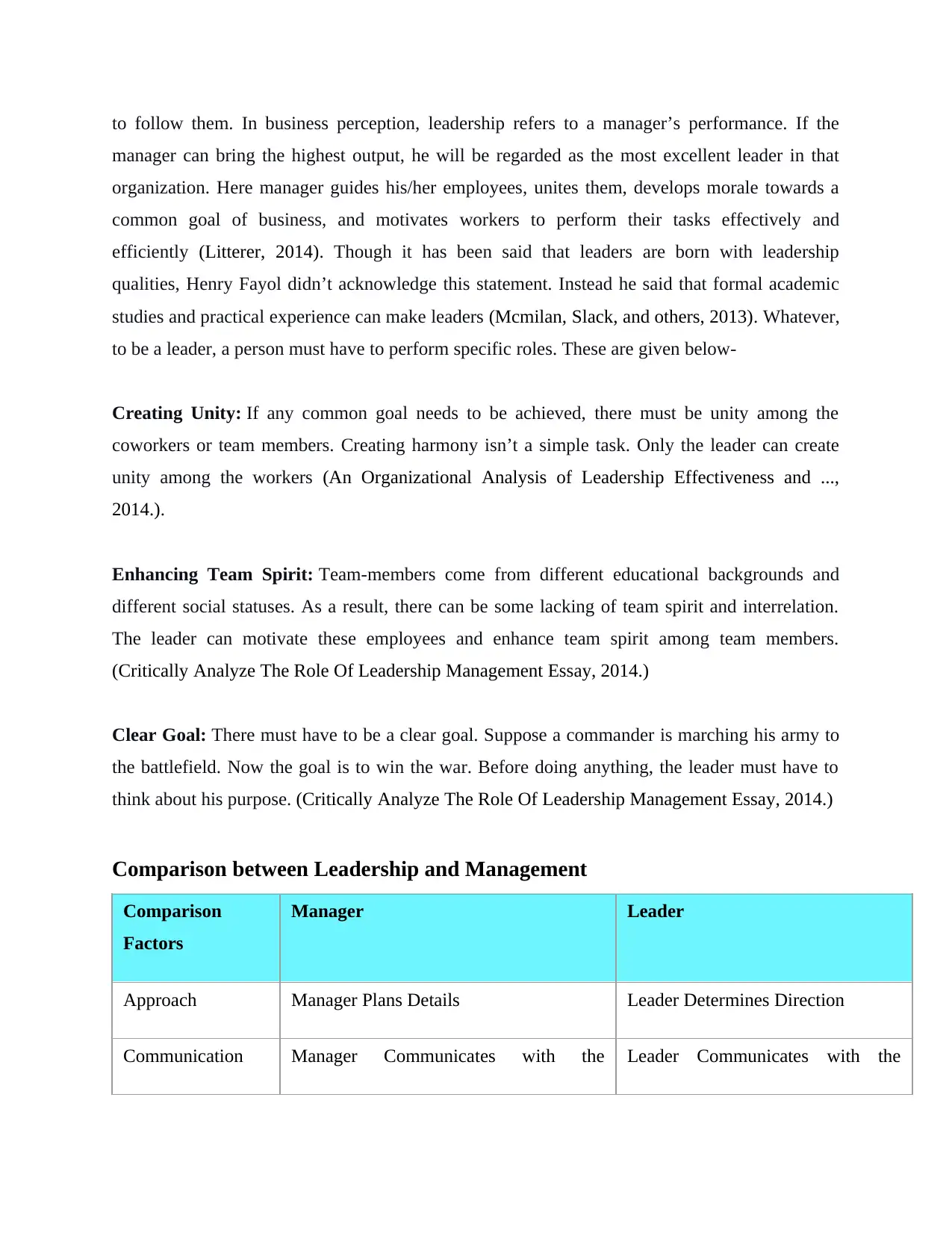
to follow them. In business perception, leadership refers to a manager’s performance. If the
manager can bring the highest output, he will be regarded as the most excellent leader in that
organization. Here manager guides his/her employees, unites them, develops morale towards a
common goal of business, and motivates workers to perform their tasks effectively and
efficiently (Litterer, 2014). Though it has been said that leaders are born with leadership
qualities, Henry Fayol didn’t acknowledge this statement. Instead he said that formal academic
studies and practical experience can make leaders (Mcmilan, Slack, and others, 2013). Whatever,
to be a leader, a person must have to perform specific roles. These are given below-
Creating Unity: If any common goal needs to be achieved, there must be unity among the
coworkers or team members. Creating harmony isn’t a simple task. Only the leader can create
unity among the workers (An Organizational Analysis of Leadership Effectiveness and ...,
2014.).
Enhancing Team Spirit: Team-members come from different educational backgrounds and
different social statuses. As a result, there can be some lacking of team spirit and interrelation.
The leader can motivate these employees and enhance team spirit among team members.
(Critically Analyze The Role Of Leadership Management Essay, 2014.)
Clear Goal: There must have to be a clear goal. Suppose a commander is marching his army to
the battlefield. Now the goal is to win the war. Before doing anything, the leader must have to
think about his purpose. (Critically Analyze The Role Of Leadership Management Essay, 2014.)
Comparison between Leadership and Management
Comparison
Factors
Manager Leader
Approach Manager Plans Details Leader Determines Direction
Communication Manager Communicates with the Leader Communicates with the
manager can bring the highest output, he will be regarded as the most excellent leader in that
organization. Here manager guides his/her employees, unites them, develops morale towards a
common goal of business, and motivates workers to perform their tasks effectively and
efficiently (Litterer, 2014). Though it has been said that leaders are born with leadership
qualities, Henry Fayol didn’t acknowledge this statement. Instead he said that formal academic
studies and practical experience can make leaders (Mcmilan, Slack, and others, 2013). Whatever,
to be a leader, a person must have to perform specific roles. These are given below-
Creating Unity: If any common goal needs to be achieved, there must be unity among the
coworkers or team members. Creating harmony isn’t a simple task. Only the leader can create
unity among the workers (An Organizational Analysis of Leadership Effectiveness and ...,
2014.).
Enhancing Team Spirit: Team-members come from different educational backgrounds and
different social statuses. As a result, there can be some lacking of team spirit and interrelation.
The leader can motivate these employees and enhance team spirit among team members.
(Critically Analyze The Role Of Leadership Management Essay, 2014.)
Clear Goal: There must have to be a clear goal. Suppose a commander is marching his army to
the battlefield. Now the goal is to win the war. Before doing anything, the leader must have to
think about his purpose. (Critically Analyze The Role Of Leadership Management Essay, 2014.)
Comparison between Leadership and Management
Comparison
Factors
Manager Leader
Approach Manager Plans Details Leader Determines Direction
Communication Manager Communicates with the Leader Communicates with the
Paraphrase This Document
Need a fresh take? Get an instant paraphrase of this document with our AI Paraphraser
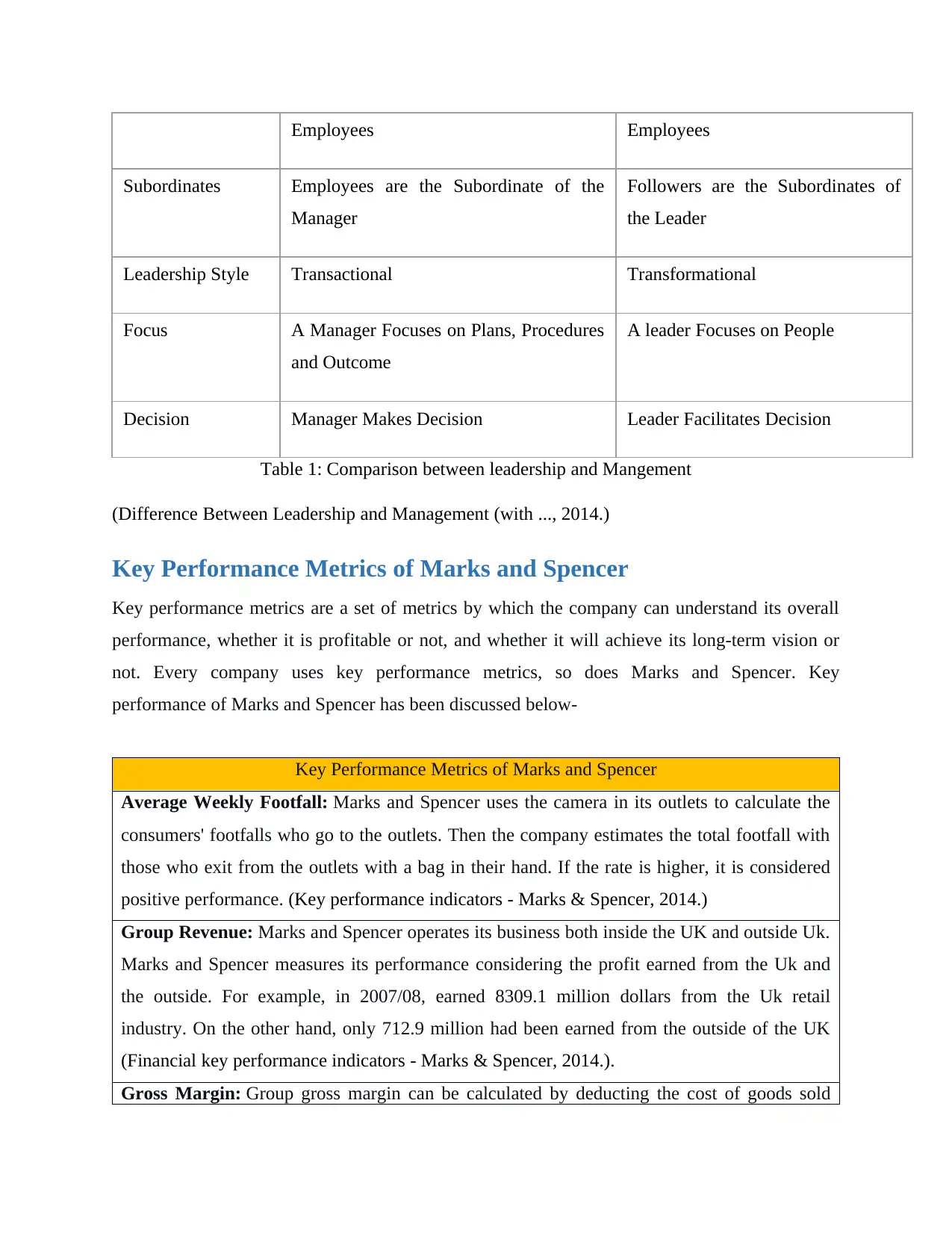
Employees Employees
Subordinates Employees are the Subordinate of the
Manager
Followers are the Subordinates of
the Leader
Leadership Style Transactional Transformational
Focus A Manager Focuses on Plans, Procedures
and Outcome
A leader Focuses on People
Decision Manager Makes Decision Leader Facilitates Decision
Table 1: Comparison between leadership and Mangement
(Difference Between Leadership and Management (with ..., 2014.)
Key Performance Metrics of Marks and Spencer
Key performance metrics are a set of metrics by which the company can understand its overall
performance, whether it is profitable or not, and whether it will achieve its long-term vision or
not. Every company uses key performance metrics, so does Marks and Spencer. Key
performance of Marks and Spencer has been discussed below-
Key Performance Metrics of Marks and Spencer
Average Weekly Footfall: Marks and Spencer uses the camera in its outlets to calculate the
consumers' footfalls who go to the outlets. Then the company estimates the total footfall with
those who exit from the outlets with a bag in their hand. If the rate is higher, it is considered
positive performance. (Key performance indicators - Marks & Spencer, 2014.)
Group Revenue: Marks and Spencer operates its business both inside the UK and outside Uk.
Marks and Spencer measures its performance considering the profit earned from the Uk and
the outside. For example, in 2007/08, earned 8309.1 million dollars from the Uk retail
industry. On the other hand, only 712.9 million had been earned from the outside of the UK
(Financial key performance indicators - Marks & Spencer, 2014.).
Gross Margin: Group gross margin can be calculated by deducting the cost of goods sold
Subordinates Employees are the Subordinate of the
Manager
Followers are the Subordinates of
the Leader
Leadership Style Transactional Transformational
Focus A Manager Focuses on Plans, Procedures
and Outcome
A leader Focuses on People
Decision Manager Makes Decision Leader Facilitates Decision
Table 1: Comparison between leadership and Mangement
(Difference Between Leadership and Management (with ..., 2014.)
Key Performance Metrics of Marks and Spencer
Key performance metrics are a set of metrics by which the company can understand its overall
performance, whether it is profitable or not, and whether it will achieve its long-term vision or
not. Every company uses key performance metrics, so does Marks and Spencer. Key
performance of Marks and Spencer has been discussed below-
Key Performance Metrics of Marks and Spencer
Average Weekly Footfall: Marks and Spencer uses the camera in its outlets to calculate the
consumers' footfalls who go to the outlets. Then the company estimates the total footfall with
those who exit from the outlets with a bag in their hand. If the rate is higher, it is considered
positive performance. (Key performance indicators - Marks & Spencer, 2014.)
Group Revenue: Marks and Spencer operates its business both inside the UK and outside Uk.
Marks and Spencer measures its performance considering the profit earned from the Uk and
the outside. For example, in 2007/08, earned 8309.1 million dollars from the Uk retail
industry. On the other hand, only 712.9 million had been earned from the outside of the UK
(Financial key performance indicators - Marks & Spencer, 2014.).
Gross Margin: Group gross margin can be calculated by deducting the cost of goods sold
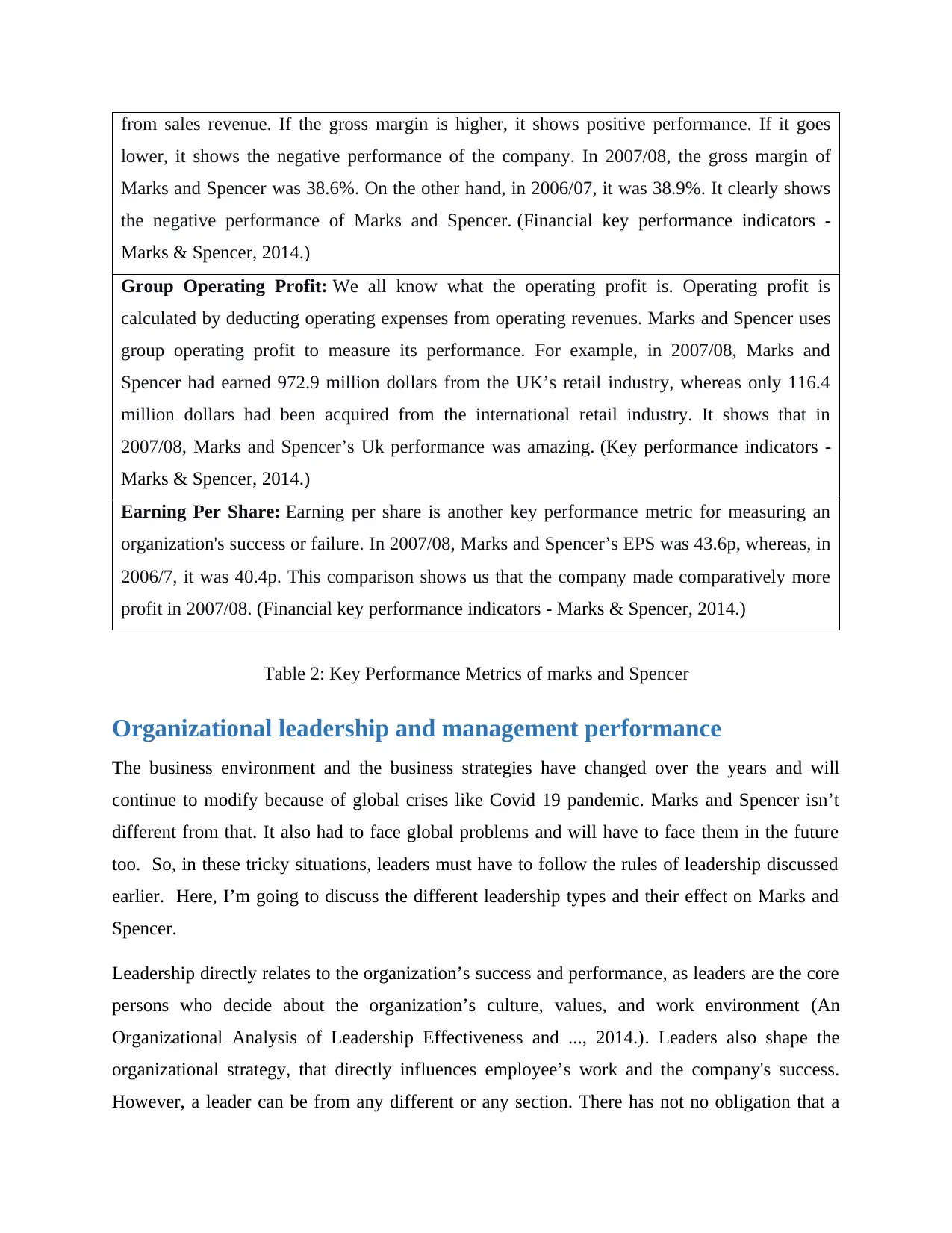
from sales revenue. If the gross margin is higher, it shows positive performance. If it goes
lower, it shows the negative performance of the company. In 2007/08, the gross margin of
Marks and Spencer was 38.6%. On the other hand, in 2006/07, it was 38.9%. It clearly shows
the negative performance of Marks and Spencer. (Financial key performance indicators -
Marks & Spencer, 2014.)
Group Operating Profit: We all know what the operating profit is. Operating profit is
calculated by deducting operating expenses from operating revenues. Marks and Spencer uses
group operating profit to measure its performance. For example, in 2007/08, Marks and
Spencer had earned 972.9 million dollars from the UK’s retail industry, whereas only 116.4
million dollars had been acquired from the international retail industry. It shows that in
2007/08, Marks and Spencer’s Uk performance was amazing. (Key performance indicators -
Marks & Spencer, 2014.)
Earning Per Share: Earning per share is another key performance metric for measuring an
organization's success or failure. In 2007/08, Marks and Spencer’s EPS was 43.6p, whereas, in
2006/7, it was 40.4p. This comparison shows us that the company made comparatively more
profit in 2007/08. (Financial key performance indicators - Marks & Spencer, 2014.)
Table 2: Key Performance Metrics of marks and Spencer
Organizational leadership and management performance
The business environment and the business strategies have changed over the years and will
continue to modify because of global crises like Covid 19 pandemic. Marks and Spencer isn’t
different from that. It also had to face global problems and will have to face them in the future
too. So, in these tricky situations, leaders must have to follow the rules of leadership discussed
earlier. Here, I’m going to discuss the different leadership types and their effect on Marks and
Spencer.
Leadership directly relates to the organization’s success and performance, as leaders are the core
persons who decide about the organization’s culture, values, and work environment (An
Organizational Analysis of Leadership Effectiveness and ..., 2014.). Leaders also shape the
organizational strategy, that directly influences employee’s work and the company's success.
However, a leader can be from any different or any section. There has not no obligation that a
lower, it shows the negative performance of the company. In 2007/08, the gross margin of
Marks and Spencer was 38.6%. On the other hand, in 2006/07, it was 38.9%. It clearly shows
the negative performance of Marks and Spencer. (Financial key performance indicators -
Marks & Spencer, 2014.)
Group Operating Profit: We all know what the operating profit is. Operating profit is
calculated by deducting operating expenses from operating revenues. Marks and Spencer uses
group operating profit to measure its performance. For example, in 2007/08, Marks and
Spencer had earned 972.9 million dollars from the UK’s retail industry, whereas only 116.4
million dollars had been acquired from the international retail industry. It shows that in
2007/08, Marks and Spencer’s Uk performance was amazing. (Key performance indicators -
Marks & Spencer, 2014.)
Earning Per Share: Earning per share is another key performance metric for measuring an
organization's success or failure. In 2007/08, Marks and Spencer’s EPS was 43.6p, whereas, in
2006/7, it was 40.4p. This comparison shows us that the company made comparatively more
profit in 2007/08. (Financial key performance indicators - Marks & Spencer, 2014.)
Table 2: Key Performance Metrics of marks and Spencer
Organizational leadership and management performance
The business environment and the business strategies have changed over the years and will
continue to modify because of global crises like Covid 19 pandemic. Marks and Spencer isn’t
different from that. It also had to face global problems and will have to face them in the future
too. So, in these tricky situations, leaders must have to follow the rules of leadership discussed
earlier. Here, I’m going to discuss the different leadership types and their effect on Marks and
Spencer.
Leadership directly relates to the organization’s success and performance, as leaders are the core
persons who decide about the organization’s culture, values, and work environment (An
Organizational Analysis of Leadership Effectiveness and ..., 2014.). Leaders also shape the
organizational strategy, that directly influences employee’s work and the company's success.
However, a leader can be from any different or any section. There has not no obligation that a
⊘ This is a preview!⊘
Do you want full access?
Subscribe today to unlock all pages.

Trusted by 1+ million students worldwide
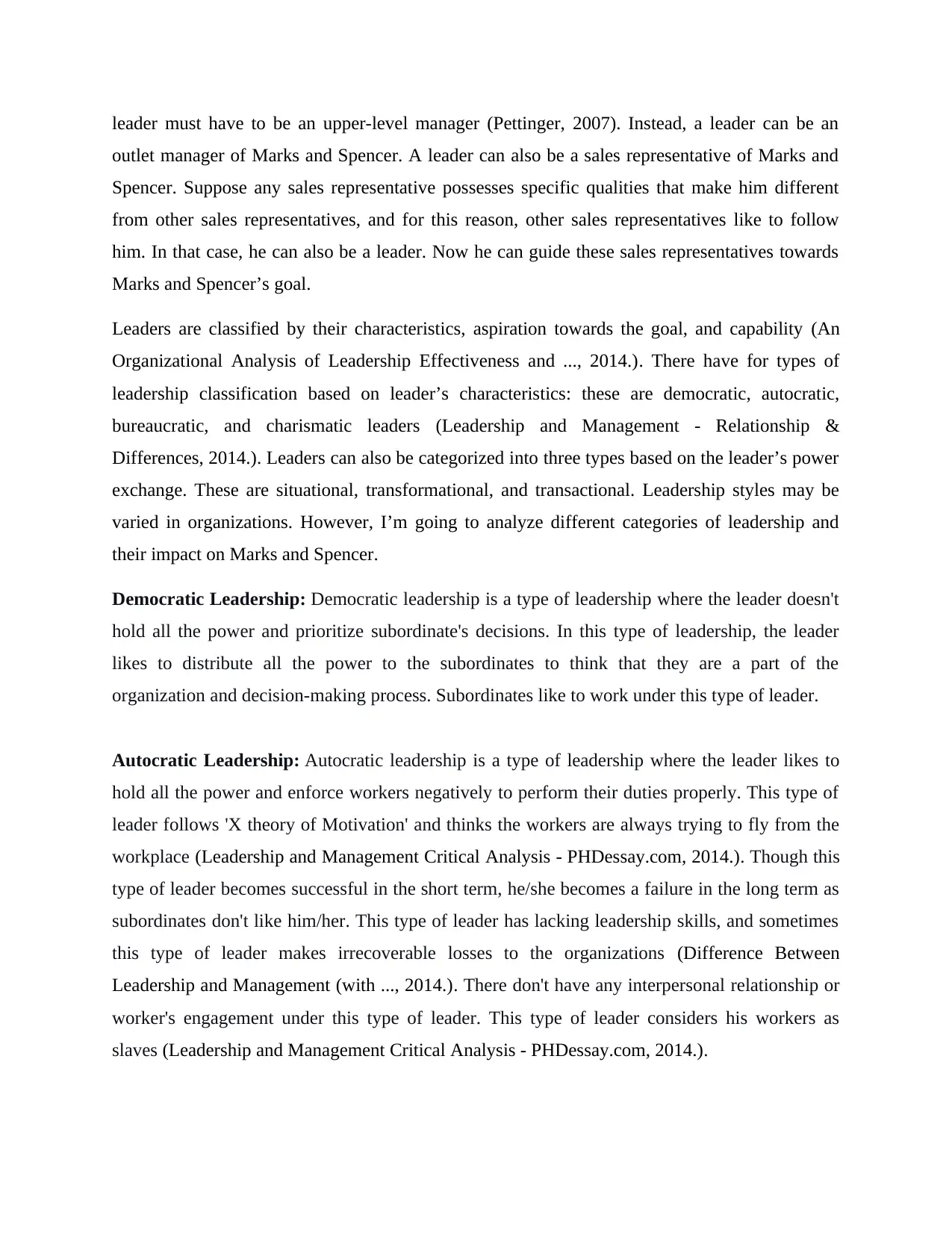
leader must have to be an upper-level manager (Pettinger, 2007). Instead, a leader can be an
outlet manager of Marks and Spencer. A leader can also be a sales representative of Marks and
Spencer. Suppose any sales representative possesses specific qualities that make him different
from other sales representatives, and for this reason, other sales representatives like to follow
him. In that case, he can also be a leader. Now he can guide these sales representatives towards
Marks and Spencer’s goal.
Leaders are classified by their characteristics, aspiration towards the goal, and capability (An
Organizational Analysis of Leadership Effectiveness and ..., 2014.). There have for types of
leadership classification based on leader’s characteristics: these are democratic, autocratic,
bureaucratic, and charismatic leaders (Leadership and Management - Relationship &
Differences, 2014.). Leaders can also be categorized into three types based on the leader’s power
exchange. These are situational, transformational, and transactional. Leadership styles may be
varied in organizations. However, I’m going to analyze different categories of leadership and
their impact on Marks and Spencer.
Democratic Leadership: Democratic leadership is a type of leadership where the leader doesn't
hold all the power and prioritize subordinate's decisions. In this type of leadership, the leader
likes to distribute all the power to the subordinates to think that they are a part of the
organization and decision-making process. Subordinates like to work under this type of leader.
Autocratic Leadership: Autocratic leadership is a type of leadership where the leader likes to
hold all the power and enforce workers negatively to perform their duties properly. This type of
leader follows 'X theory of Motivation' and thinks the workers are always trying to fly from the
workplace (Leadership and Management Critical Analysis - PHDessay.com, 2014.). Though this
type of leader becomes successful in the short term, he/she becomes a failure in the long term as
subordinates don't like him/her. This type of leader has lacking leadership skills, and sometimes
this type of leader makes irrecoverable losses to the organizations (Difference Between
Leadership and Management (with ..., 2014.). There don't have any interpersonal relationship or
worker's engagement under this type of leader. This type of leader considers his workers as
slaves (Leadership and Management Critical Analysis - PHDessay.com, 2014.).
outlet manager of Marks and Spencer. A leader can also be a sales representative of Marks and
Spencer. Suppose any sales representative possesses specific qualities that make him different
from other sales representatives, and for this reason, other sales representatives like to follow
him. In that case, he can also be a leader. Now he can guide these sales representatives towards
Marks and Spencer’s goal.
Leaders are classified by their characteristics, aspiration towards the goal, and capability (An
Organizational Analysis of Leadership Effectiveness and ..., 2014.). There have for types of
leadership classification based on leader’s characteristics: these are democratic, autocratic,
bureaucratic, and charismatic leaders (Leadership and Management - Relationship &
Differences, 2014.). Leaders can also be categorized into three types based on the leader’s power
exchange. These are situational, transformational, and transactional. Leadership styles may be
varied in organizations. However, I’m going to analyze different categories of leadership and
their impact on Marks and Spencer.
Democratic Leadership: Democratic leadership is a type of leadership where the leader doesn't
hold all the power and prioritize subordinate's decisions. In this type of leadership, the leader
likes to distribute all the power to the subordinates to think that they are a part of the
organization and decision-making process. Subordinates like to work under this type of leader.
Autocratic Leadership: Autocratic leadership is a type of leadership where the leader likes to
hold all the power and enforce workers negatively to perform their duties properly. This type of
leader follows 'X theory of Motivation' and thinks the workers are always trying to fly from the
workplace (Leadership and Management Critical Analysis - PHDessay.com, 2014.). Though this
type of leader becomes successful in the short term, he/she becomes a failure in the long term as
subordinates don't like him/her. This type of leader has lacking leadership skills, and sometimes
this type of leader makes irrecoverable losses to the organizations (Difference Between
Leadership and Management (with ..., 2014.). There don't have any interpersonal relationship or
worker's engagement under this type of leader. This type of leader considers his workers as
slaves (Leadership and Management Critical Analysis - PHDessay.com, 2014.).
Paraphrase This Document
Need a fresh take? Get an instant paraphrase of this document with our AI Paraphraser
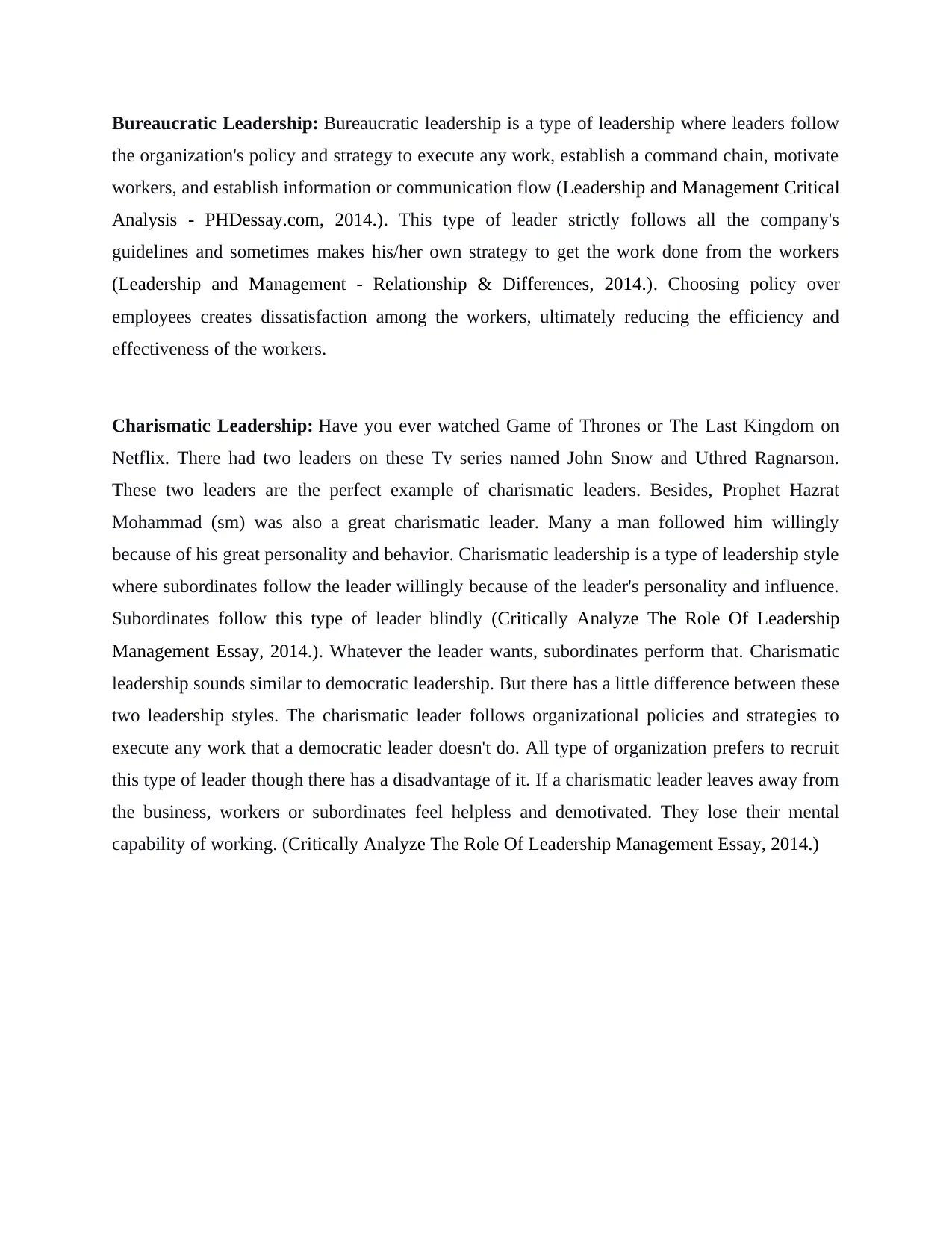
Bureaucratic Leadership: Bureaucratic leadership is a type of leadership where leaders follow
the organization's policy and strategy to execute any work, establish a command chain, motivate
workers, and establish information or communication flow (Leadership and Management Critical
Analysis - PHDessay.com, 2014.). This type of leader strictly follows all the company's
guidelines and sometimes makes his/her own strategy to get the work done from the workers
(Leadership and Management - Relationship & Differences, 2014.). Choosing policy over
employees creates dissatisfaction among the workers, ultimately reducing the efficiency and
effectiveness of the workers.
Charismatic Leadership: Have you ever watched Game of Thrones or The Last Kingdom on
Netflix. There had two leaders on these Tv series named John Snow and Uthred Ragnarson.
These two leaders are the perfect example of charismatic leaders. Besides, Prophet Hazrat
Mohammad (sm) was also a great charismatic leader. Many a man followed him willingly
because of his great personality and behavior. Charismatic leadership is a type of leadership style
where subordinates follow the leader willingly because of the leader's personality and influence.
Subordinates follow this type of leader blindly (Critically Analyze The Role Of Leadership
Management Essay, 2014.). Whatever the leader wants, subordinates perform that. Charismatic
leadership sounds similar to democratic leadership. But there has a little difference between these
two leadership styles. The charismatic leader follows organizational policies and strategies to
execute any work that a democratic leader doesn't do. All type of organization prefers to recruit
this type of leader though there has a disadvantage of it. If a charismatic leader leaves away from
the business, workers or subordinates feel helpless and demotivated. They lose their mental
capability of working. (Critically Analyze The Role Of Leadership Management Essay, 2014.)
the organization's policy and strategy to execute any work, establish a command chain, motivate
workers, and establish information or communication flow (Leadership and Management Critical
Analysis - PHDessay.com, 2014.). This type of leader strictly follows all the company's
guidelines and sometimes makes his/her own strategy to get the work done from the workers
(Leadership and Management - Relationship & Differences, 2014.). Choosing policy over
employees creates dissatisfaction among the workers, ultimately reducing the efficiency and
effectiveness of the workers.
Charismatic Leadership: Have you ever watched Game of Thrones or The Last Kingdom on
Netflix. There had two leaders on these Tv series named John Snow and Uthred Ragnarson.
These two leaders are the perfect example of charismatic leaders. Besides, Prophet Hazrat
Mohammad (sm) was also a great charismatic leader. Many a man followed him willingly
because of his great personality and behavior. Charismatic leadership is a type of leadership style
where subordinates follow the leader willingly because of the leader's personality and influence.
Subordinates follow this type of leader blindly (Critically Analyze The Role Of Leadership
Management Essay, 2014.). Whatever the leader wants, subordinates perform that. Charismatic
leadership sounds similar to democratic leadership. But there has a little difference between these
two leadership styles. The charismatic leader follows organizational policies and strategies to
execute any work that a democratic leader doesn't do. All type of organization prefers to recruit
this type of leader though there has a disadvantage of it. If a charismatic leader leaves away from
the business, workers or subordinates feel helpless and demotivated. They lose their mental
capability of working. (Critically Analyze The Role Of Leadership Management Essay, 2014.)
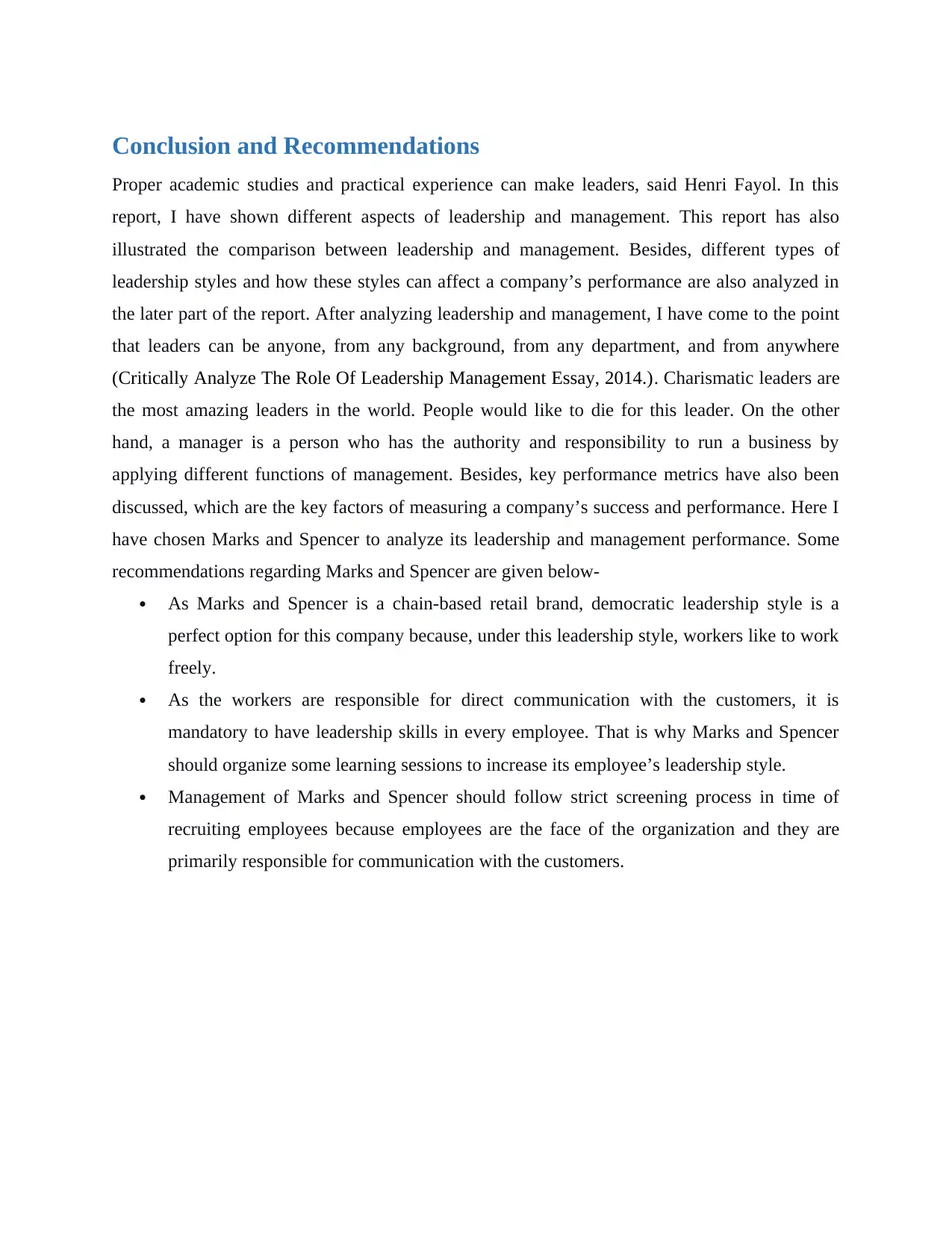
Conclusion and Recommendations
Proper academic studies and practical experience can make leaders, said Henri Fayol. In this
report, I have shown different aspects of leadership and management. This report has also
illustrated the comparison between leadership and management. Besides, different types of
leadership styles and how these styles can affect a company’s performance are also analyzed in
the later part of the report. After analyzing leadership and management, I have come to the point
that leaders can be anyone, from any background, from any department, and from anywhere
(Critically Analyze The Role Of Leadership Management Essay, 2014.). Charismatic leaders are
the most amazing leaders in the world. People would like to die for this leader. On the other
hand, a manager is a person who has the authority and responsibility to run a business by
applying different functions of management. Besides, key performance metrics have also been
discussed, which are the key factors of measuring a company’s success and performance. Here I
have chosen Marks and Spencer to analyze its leadership and management performance. Some
recommendations regarding Marks and Spencer are given below-
As Marks and Spencer is a chain-based retail brand, democratic leadership style is a
perfect option for this company because, under this leadership style, workers like to work
freely.
As the workers are responsible for direct communication with the customers, it is
mandatory to have leadership skills in every employee. That is why Marks and Spencer
should organize some learning sessions to increase its employee’s leadership style.
Management of Marks and Spencer should follow strict screening process in time of
recruiting employees because employees are the face of the organization and they are
primarily responsible for communication with the customers.
Proper academic studies and practical experience can make leaders, said Henri Fayol. In this
report, I have shown different aspects of leadership and management. This report has also
illustrated the comparison between leadership and management. Besides, different types of
leadership styles and how these styles can affect a company’s performance are also analyzed in
the later part of the report. After analyzing leadership and management, I have come to the point
that leaders can be anyone, from any background, from any department, and from anywhere
(Critically Analyze The Role Of Leadership Management Essay, 2014.). Charismatic leaders are
the most amazing leaders in the world. People would like to die for this leader. On the other
hand, a manager is a person who has the authority and responsibility to run a business by
applying different functions of management. Besides, key performance metrics have also been
discussed, which are the key factors of measuring a company’s success and performance. Here I
have chosen Marks and Spencer to analyze its leadership and management performance. Some
recommendations regarding Marks and Spencer are given below-
As Marks and Spencer is a chain-based retail brand, democratic leadership style is a
perfect option for this company because, under this leadership style, workers like to work
freely.
As the workers are responsible for direct communication with the customers, it is
mandatory to have leadership skills in every employee. That is why Marks and Spencer
should organize some learning sessions to increase its employee’s leadership style.
Management of Marks and Spencer should follow strict screening process in time of
recruiting employees because employees are the face of the organization and they are
primarily responsible for communication with the customers.
⊘ This is a preview!⊘
Do you want full access?
Subscribe today to unlock all pages.

Trusted by 1+ million students worldwide
1 out of 22
Related Documents
Your All-in-One AI-Powered Toolkit for Academic Success.
+13062052269
info@desklib.com
Available 24*7 on WhatsApp / Email
![[object Object]](/_next/static/media/star-bottom.7253800d.svg)
Unlock your academic potential
Copyright © 2020–2025 A2Z Services. All Rights Reserved. Developed and managed by ZUCOL.





